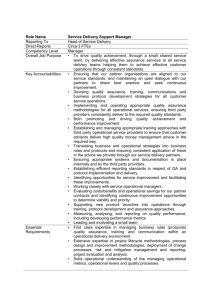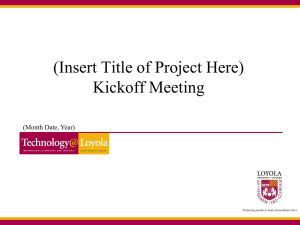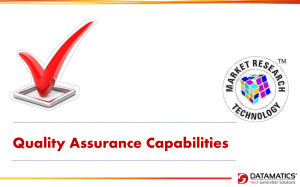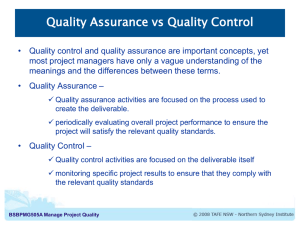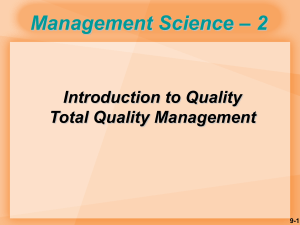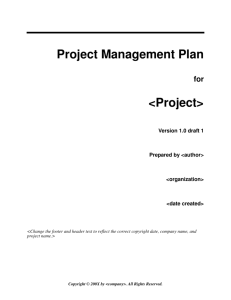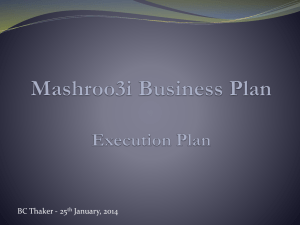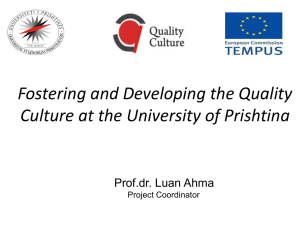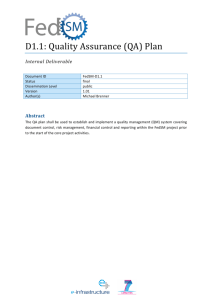Information System
advertisement
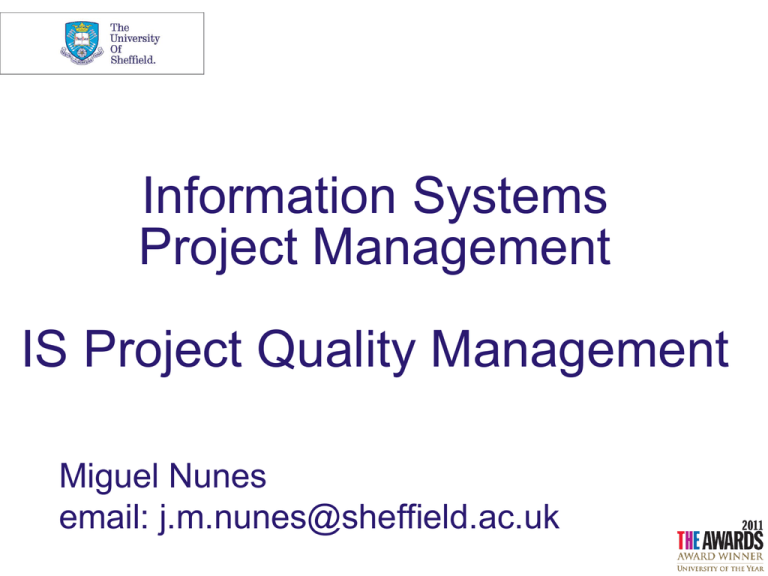
Information Systems Project Management IS Project Quality Management Miguel Nunes email: j.m.nunes@sheffield.ac.uk Aims of this Session • To introduce basic concepts of quality assurance and management; • To discuss methods, activities and factors involved in quality management; • To discuss quality assurance at the different stages of IS project management. 3 Information System Definition An Information System can be defined technically as a set of interrelated components that collect, process, store and retrieve, and distribute information to support decision making, co-ordination and control in an organisation. An information system is an organisational and management solution, based on information and communication technology, to a challenge posed by the environment. Information System Definition A system that assembles, stores, processes and delivers information relevant to an organisation (or socio-technical environment), in such a way that the information is accessible and useful to those who wish to use it as required by their activity practices, including managers, staff, customers, suppliers, other business partners and citizens. An IS is therefore an human-activity system which may or may not involve the use of IT based systems. Types of IS Project Resources Any IS project has at least 4 stages: start-up; development; completion; operational. 5 Types of IS Project Resources A resource is any item or person required for the execution of the project (from clips to key technical personnel). In general resources can be categorised as follows: Labour (also known as Human Resources); Equipment; Materials; Space; Services; Time; Budgetary resources. 6 Types of IS Project Resources These team members may take one or more of the following types of roles: Support: Management: Technical: Project Manager; Quality Manager; Risk Manager; Configuration and Integration Manager; Analysts and Designers; Programmers; Graphics Designer; Database Administrator; Implementation Officer; Users; Testers; Project Champion; Secretaries; Clerks; Training Officer: Organising: And more ………. Steering Committee; User Group; Risk Management Committee; Joint Application Development Team. 7 Types of IS Project Resources Human Resources is very expensive (typically 80% of budget of the project) and the more specialised the resources are the more scarce and expensive they become. Human resource allocation depends on: Management Style of Project Manager. Type and nature of the project; IS Methodology Selected; Constraints and Budget of the Project. 8 Types of IS Project Resources Time is a resource that is very scarce and limits the use of other resources. Time allocation in the plan depends on IS methodology, effort estimation, quality standards used, risk management and the use of human resources. 9 IS Development Methodologies “ a coherent collection of concepts, beliefs, values and principles supported by resources to help a problemsolving group to perceive, generate, assess and carryout in a non-random way changes to the information system” (Avison and Wood-Harper, 1990) 1. Set of methods for tackling the different problems involved. 2. Sound theoretical basis in order to understand why and when to use the methods. IS Development Methodologies A collection of procedures, techniques, tools and documentation aids that help developers in their efforts to understand users, their socio-technical environment, their work practices and their information needs. IS Methodologies consist of phases whish will guide the systems developers in what to do and their choice of techniques that might be appropriate at each stage. Each phase may contain subphases. These phases (or stages, or main activities) form the IS Project and help manage, control and evaluate the project. 11 IS Development Methodologies There are 3 main types of methodologies in use today: Structured Approaches (e.g. SSDAM); Agile Methodologies: Prototyping approaches (e.g. RAD or DSDM); Incremental approaches (e.g. XP or SCRUM); Object Oriented Approaches (e.g. UML). 12 Process-Based Estimation Allocation of time and human resources should be is based on Process Based Estimation ... supported by DTL and WBS and expressed in terms of Gantt and CPM charts. Process decomposition sets of: Stages into activities Activities into tasks. Consideration of past experience and data from past projects through: expert judgement; or analogy. Consideration of “especial factors” (individual skill, support tools, communication and co-ordination problems); Estimation of effort required for each individual task. Information Systems Project Planning Time allocation in the plan depends on the IS methodology selected, effort estimation, quality standards used, risk management and the use of human resources. Question answered: What IS Methodology to use? Who will do the work? When will the work be done? How long will each of the stages, activities and tasks last? Questions remaining: What type of quality do we need for our work and product? What risks are we willing to run? Project Quality IS Project quality refers to the quality of the project as whole, including all the products and processes related to achieving these such as, analysis, management, scheduling, human resources, as well as, ‘system quality’, that refers to technical considerations such as, software, hardware, environment in which it operates, etc. Quality Concepts Quality: The totality of features and characteristics of a product or service that bear on its ability to satisfy stated or implied needs. Two types of Quality Assurance: Validation Are we building the right product? (external) Verification Are we building the product right? (internal) Quality Concepts Two types of Quality: Quality of Conformance: the degree to which a project conforms to its specification as agreed with its originator (validation). Quality of the Process: the suitability of the specification, design, development and installation process to fulfil its agreed purpose or function including both internal and external needs (verification). Quality of Conformance • Project team and originator understand and agree what is needed; • Deliverables are formally reviewed and remediation measures are taken in case of failure to meet standards and requirements; • Project team supplies suitable IS system; • Originator formally acknowledges reception and suitability of IS. Quality of Conformance The jargon: A defect is anything that is wrong with a product, whether an omission, imperfection, ambiguity or fault; A fault or bug is the cause or potential cause of a failure; A failure is either a breakdown of some sort or the production of wrong or otherwise unsatisfactory results; Finally, an error is a human action or mistake that results in an IS fault. Quality of the Process Project team agrees on a monitoring strategy and a project plan; Project progress is monitored accordingly and remediation actions are taken whenever necessary; Deliverables are formally reviewed and remediation measures are taken in case of failure of the work processes to meet internal and professional standards; Process is evaluated and reviewed at the end of the project against plan, organisational requirements and aims, as well as suitability to support similar porjects in the future. Quality of the Process The jargon: Plan, schedule, stages, activities, tasks, communication, integration of efforts, motivation, support tools, methodology, techniques ... That is aspects linked with the process and the achievement of final and intermediate products, rather tan the quality of the products themselves. Quality Assurance • Evaluate the results of the different stages throughout the whole project; • Confirm that these results have been appropriately reached by the scheduled date; • Confirm that the work is done at internal, external and professional standards; • Ensure the existence of appropriate communications between the different parts involved and especially between IT/IS Specialists and Customers. Quality Assurance Quality assurance is based on two main concepts: A milestone is a point in time at wich a stage of the project is considered to be completed and this is accepted by both the project team and the originator for external ones or just the team for internal ones: • They provide control points at which we can evaluate progress and adjust project plans; • They can be used to illustrate progress to the originator; • There may be intermediates sign-offs, stage payments or renegotiations linked to the achievement of milestones. A deliverable finalised products that emerge from different phases of the project (e.g. Documents, Reports, Specifications, Code, etc). Quality Assurance Milestone as well as type and nature of deliverables depend on the IS Methdology selected !!!! Are milestones the same for SSADM, RAD, XP and UML? Are deliverables the same? Why? Quality Assurance Quality of Conformance: checks every deliverable associated with each milestone against agreed requirements, necessary functionality and contracted objectives as well as external and professional standards (validation). Quality of the Process: checks the suitability of the processes associated with achieving a specific milestone against their agreed purpose or function including both internal and external standards and needs (verification). Why Quality Assurance? Cost of Quality against Time Ahh … but this is a bit boring …. This module’s question: “We know why projects fail, we know how to prevent their failure -- so why do they still fail?“ Cobb (1995) Old question!??? Project Management What has happened ? What is happening ? What is going to happen ? What needs to be done ? How are we going to do it ? When are we doing it ? Who is going to do it ? What is the quality of our work (product) ? What are the risks involved ? Project Management Planning and Organising (What and How) Estimating ( When and Who) Scheduling and Monitoring (awareness of progression, remediation action, quality assurance) Planning and Organising Planning and Organising (What and How) Understanding requirements; Selecting a methodology; Estimating Effort; Determining deliverables and milestones; Determining verification and validation checks. Finished ? To Sum up ... If Time allocation in the plan depends on IS methodology, effort estimation, quality standards used, risk management and the use of human resources. Then we still have one question to answer. To Sum up ... Your Turn now !!!! Group 1 - UML Group 2 - XP For Tomorrow: Group 3 - RAD Group 4 - SSADM Produce a table identifying ALL the milestones (internal and external), associated deliverables and review mechanisms that your methodology needs for the specific IS Project for the case study and represent the milestones in your Gant Chart.

